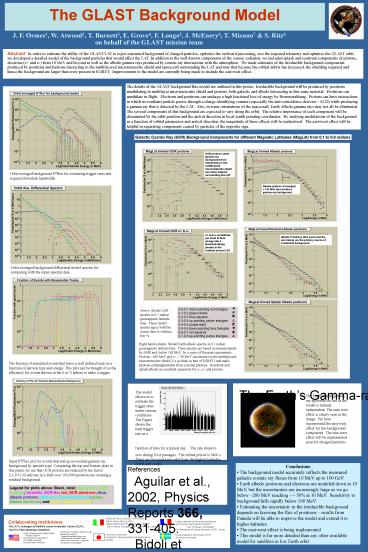The GLAST Background Model - PowerPoint PPT Presentation
1 / 1
Title:
The GLAST Background Model
Description:
The LAT is managed at Stanford Linear Accelerator Center (SLAC) ... LLR, Bordeaux, Montpellier. Commissariat a l'Energie Atomique (CEA), Saclay ... – PowerPoint PPT presentation
Number of Views:43
Avg rating:3.0/5.0
Title: The GLAST Background Model
1
The GLAST Background Model
J. F. Ormes1, W. Atwood2, T. Burnett3, E. Grove4,
F. Longo5, J. McEnery6, T. Mizuno7 S. Ritz6 on
behalf of the GLAST mission team
Abstract In order to estimate the ability of the
GLAST/LAT to reject unwanted background of
charged particles, optimize the on-board
processing, size the required telemetry and
optimize the GLAST orbit, we developed a detailed
model of the background particles that would
affect the LAT. In addition to the well-known
components of the cosmic radiation, we included
splash and reentrant components of protons,
electrons (e and e-) from 10 MeV and beyond as
well as the albedo gamma rays produced by cosmic
ray interactions with the atmosphere. We made
estimates of the irreducible background
components produced by positrons and hadrons
interacting in the multilayered micrometeorite
shield and spacecraft surrounding the LAT and
note that because the orbital debris has
increased, the shielding required and hence the
background are larger than were present in EGRET.
Improvements to the model are currently being
made to include the east-west effect.
The details of the GLAST background flux model
are outlined in this poster. Irreducible
background will be produced by positrons
annihilating in multilayer micrometeorite shield
and protons, both galactic and albedo interacting
in this same material. Positrons can annihilate
in flight. Electrons and positrons can undergo a
high fractional loss of energy by Bremsstrahlung.
Protons can have interactions in which no
resultant particle passes through a charge
identifying counter (especially the
anti-coincidence detector - ACD) while producing
a gamma ray that is detected by the LAT. Also,
in some orientations of the spacecraft, Earth
Albedo gamma rays may not all be eliminated. The
several components of this background are
expected to vary along the orbit. The relative
importance of each component will be determined
by the orbit position and the arrival direction
in local zenith pointing coordinates. By
studying modulations of the background as a
function of orbital parameters and arrival
direction, the magnitude of these effects will be
understood. The east-west effect will be helpful
in separating components caused by particles of
the opposite sign.
- Conclusions
- The background model accurately reflects the
measured galactic cosmic ray fluxes from 10 MeV
up to 100 GeV - Earth albedo positrons and electrons are modeled
down to 10 MeV, but the uncertainties are
increasingly large as we go below 200 MeV
reaching /- 50 at 10 MeV. Sensitivity to
background falls rapidly below 100 MeV. - Estimating the uncertainty in the irreducible
background depends on knowing the flux of
positrons results from Pamela will be able to
improve the model and extend it to higher
latitudes - The east-west effect is being implemented
- This model is far more detailed than any other
available model for satellites in low Earth orbit
References Aguilar et al., 2002, Physics
Reports 366, 331-405. Bidoli et al.2002,
Annales Geophysicae, 20, issue 10, 1693-1697.
Dmitriev, A.V., et al., 1998, Advances in Space
Research, Vol.21, No.12, 1797-1800. Mikhailov,
2002, J.of Mod.Phys.A, 17, Ns12-13, 1695-1704.
Petry, D., 2005, AIP Conf. Proc. 745, 709-714,
astro-ph/0410487. Voronov, S.A., et al., 1991,
Cosmic Res., Engl. Transl., 29(4), 567-575.
Voronov, S.A., S.V.Koldashov, and V.V.Mikhailov,
1995, Cosmic Res., Engl.Transl., 33(3), 329-331.
Collaborating Institutions The LAT is managed at
Stanford Linear Accelerator Center (SLAC), The
PI is Peter Michelson (Stanford)
Istituto di Fisica Cosmica, CNR (Milan) Italian
Space Agency (ASI) Istituto Nazionale di Fisica
Nucleare (INFN)5 Bari, Padova, Perugia, Pisa,
Rome, Trieste, Udine Hiroshima
University7 Institute for Space and Astronautical
Science RIKEN
Institut National de Physique Nucleaire et de
Physique des Particules (IN2P3) LLR, Bordeaux,
Montpellier Commissariat a lEnergie Atomique
(CEA), Saclay Royal Institute of Technology
(KTH) Stockholm University
University of California at Santa Cruz2 Stanford
University Hansen Experimental Physics Lab.
Stanford Linear Accelerator Center Texas AM
University Kingsville University of Washington3
NASA Goddard Space Flight Center6 University
of Denver1 Naval Research Laboratory4 Ohio State
University Sonoma State University































